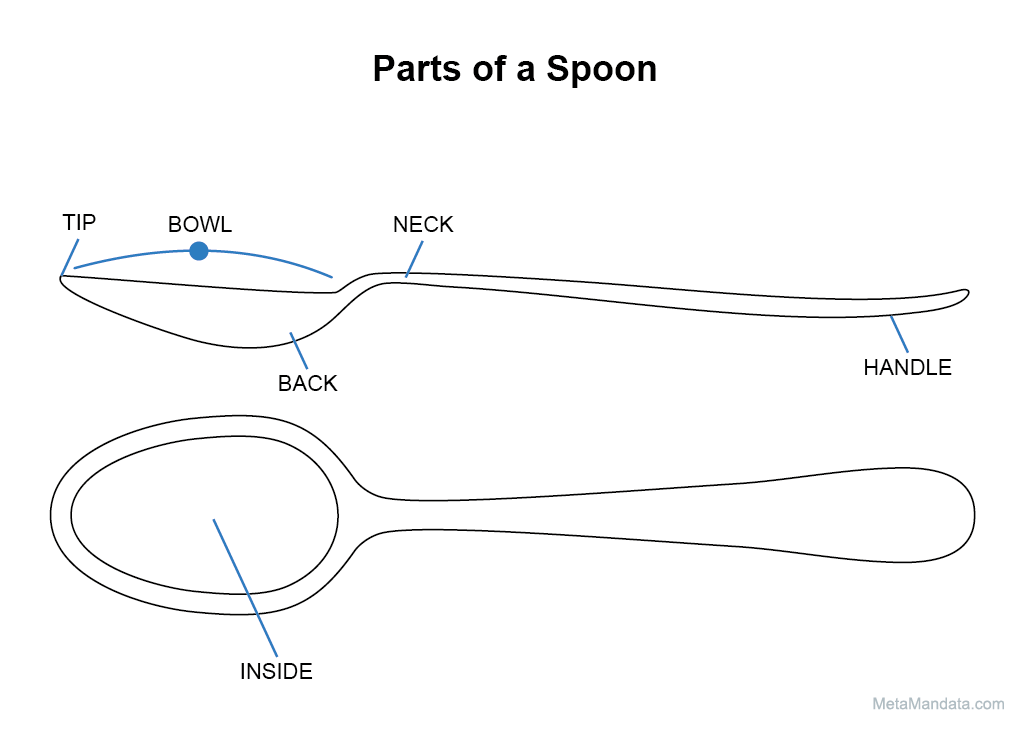Here are the 5 parts of a spoon:
- Handle
- Neck (Shoulder)
- Bowl
- Back (Heel)
- Top
So if you want to learn all about the parts of a spoon, their names, and their functions, then this article is for you.
Let’s jump right in!
Table of Contents

#1 Handle
The spoon handle is the long, often flat part from which the user holds the spoon. While it’s usually made from metal, it can also be made from different materials, such as acrylic, plastic, wood, porcelain, and silicon or rubber for babies.
One of the most recognizable and classic spoon designs, the fiddle spoon, is identified by the shape of its handle.
As you might have guessed from the name, fiddle spoon styles have a handle shaped like a fiddle or a violin, and they often have engravings, such as the sigil of royalty and important members of society in the Victorian age.
#2 Neck (Shoulder)
The neck is the narrowest and possibly thickest part of the spoon. It’s the bend that connects the handle to the bowl of the spoon.
Unlike forks, spoons have always had these necks that bend downwards as it was a crucial part of the bowl itself.
Over the decades of the popularization of spoons, this bend downwards became more pronounced to troubleshoot liquids dripping onto the holder’s hand.
In ancient Egypt, spoons were a privilege only pharaohs and the clergy had access to, and like anything that belonged to pharaohs, they had intricate designs.
The spoons of royalty were often made from carved wood, ivory, or precious stone. In most cases, the handle depicted an Egyptian deity carrying an aura (the bowl) over their heads.
#3 Bowl
The bowl of the spoon is possibly the first utensil ever invented by man. The earliest forms of spoons discovered so far were carved wood chips and shells shaped like a bowl.
Nowadays, the shape of a spoon’s bowl varies greatly and determines how it would be used. While most spoons look more or less the same, marrow, grapefruit, and sugar spoons look considerably different.
Marrow spoons have a very narrow, straight, and long bowl that is flatter than usual but has a curved tip to pull marrow out from bones.
Grapefruit spoons have triangular bowls with teeth on the tip, enabling its user to pull out a single segment of a grapefruit cut in half.
Finally, the bowls of a sugar spoon are shaped like the petals of a flower, with ridges often starting from the neck all the way to the tip. This is to make it easier for the spoon to hold loose sugar as well as sugar lumps, and stir more effectively.
#4 Back (Heel)
The back of the spoon is the part it rests on, which is the convex side of the bowl.
In much of the history of utensils, rich and royal families competed to have the most elegant dinnerware. This includes all sorts of art that were embossed onto the back of the spoon.
#5 Tip
The tip of the spoon is the outermost part of its bowl. It’s often used to cut, pry open, or break the food it’s used to eat—think soft boiled egg.
Spoon tips are often oval, but can be fully round like in soup spoons, squared like in some dessert spoons.
